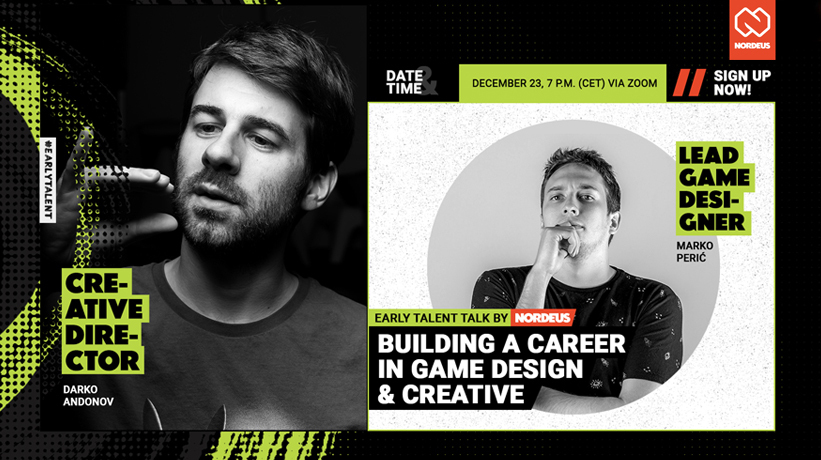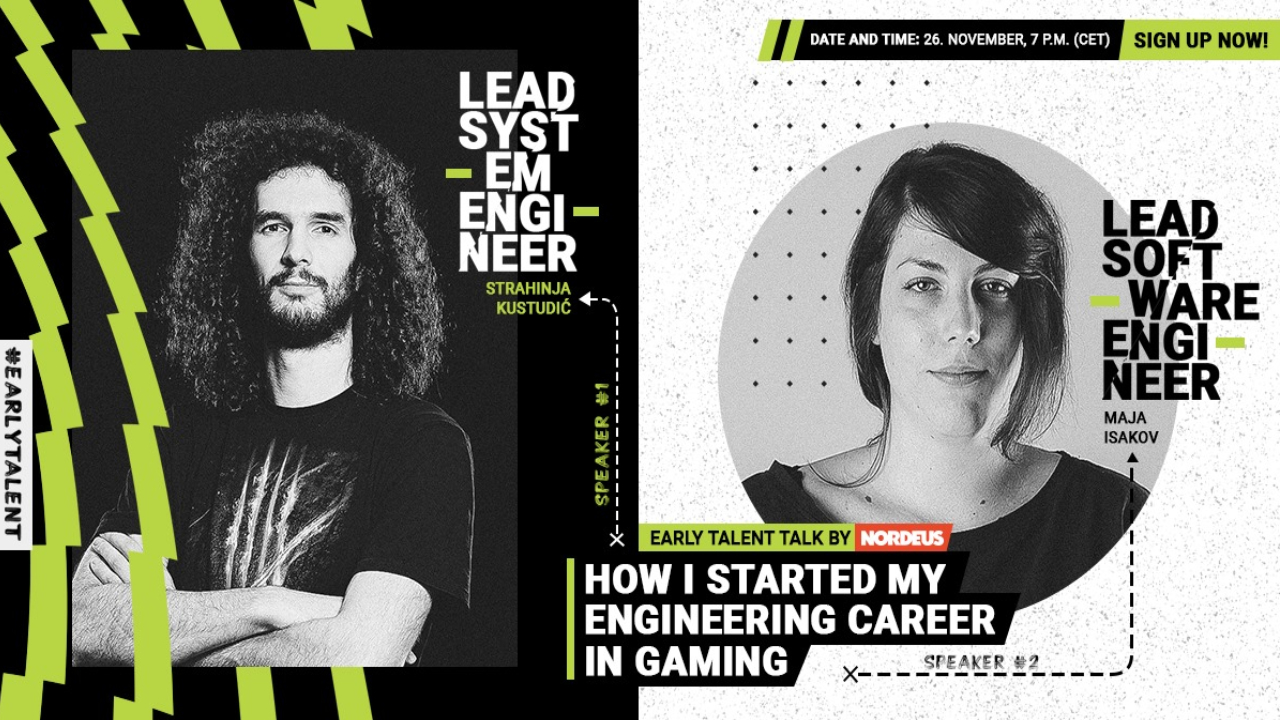Our second Nordeus Early Talent talk – Building a career in Game Design and Creative talk is live, unravelling the career journeys of our folks, this time focusing on Creative.
Creative Director, Darko Andonov, together with our Lead Game Designer, Marko Peric, spoke about the early creative sparks that led them to pursue a career in gaming, and become who they are today, professionally. They shared the projects they worked on, their career changes, and breaking the myth of educational backgrounds you are supposed to have to enter the industry.
For all of you who couldn’t make it, we pre-recorded the session, so you can check it out below. We’ve also picked the top 13 Q&As, and you can find them below the video. Thanks to everyone who sent the inquiries beforehand and during the live session hope we all learned a lot.
TAKE A LOOK:
1. WHAT IS THE BEST WAY TO ENTER THE GAMING INDUSTRY AND IS THE TALENT THE MOST IMPORTANT FACTOR IN GETTING A JOB IN A COMPANY?
Darko: All paths lead to gaming (laughs). It’s really not easy to say what the best way is. Marko and myself are good examples of people coming to work in gaming from completely different backgrounds. Regarding the talent, I would say that’s not the only relevant factor; what’s really important is your interest in games as well as the interest to learn new things, proactivity etc. Since the formal education for this industry is in development locally, we all had to carve our own ways to gaming and discovered how we can put our formal education to practice.
2. SOME TIPS AND TRICKS ON HOW TO GAIN EXPERIENCE BEFORE YOU START WORKING OR FIND AN INTERNSHIP?
Darko: For Game Design, great things are game jams, or some sort of hackathons where you can gather your friends, or people interested in the same topic, to make a game. These could last for a day or two, but this will be for sure a good reference one day when you start looking for a job. If you want to enter the industry, use your spare time to make something that will be an indicator of your interest and consecutively, a reference when seeking a job. Also, show up anywhere where you can get in contact with people who are doing the job you are interested in such as meet-ups, or gatherings like this one.
If you are specifically interested in making games, I would recommend trying to investigate different online resources about deconstructing games. Try to understand what is happening ”under the hood”, what the approaches are, how the game functions, what the rules are, what problems some game is trying to solve etc. We often organize Deconstruction clubs within Nordeus Hub. So make sure to check it out for those and other similar programs that can give you a head start in the gaming industry.
Marko: I agree, and when it comes to deconstructing, you can always try to sketch the games on paper. This might be hugely helpful for your interview process and future professional career as well.
3. CAN YOU GIVE US THE RECOMMENDATION FOR MATERIALS THAT YOU FIND USEFUL FOR LEARNING ABOUT GAME DESIGN? TIPS AND TRICKS ON HOW TO GAIN EXPERIENCE BEFORE YOU START WORKING OR FIND AN INTERNSHIP?
Marko: What I find genuinely useful are Game Developers Conference (GDC) talks. Also, you can find loads of useful videos on YouTube from people who made games, shipped successful products, and are sharing lessons they learned along the way. Another resource I found useful is Deconstructor of fun, a website where you can find articles about successful games being deconstructed, together with analysis and different opinions on what makes them so successful.
4. HOW TO MAKE AN EYE-CATCHING PORTFOLIO?
Darko: Keeping in mind the digital age we live in, there are a variety of options to do this. You can use platforms such as Behance or ArtStation to showcase the stuff you are working on, maybe even as a hobby. Yes, don’t underestimate your “amateur” projects. Even though they were not done in a professional environment, they can still complement your skills and motivation. If you want to enter the industry, use your spare time to make something that will be an indicator of your interest and consequently, a reference when looking for a job.
5. WHAT MAKES A GOOD GAME DESIGNER IN YOUR OPINION?
Marko: It really depends on the seniority of the GD role we are looking for. For junior Game Designers, I think the most important thing is for that person to love to play games, but also to love to make games for other people (not just focus on yourself and what you like). Also, you need to be ready to learn outside of the faculty, as in Serbia the formal education for Game Design is still in development.
Darko: For me, a good Game Designer is somebody who can really relate to users, who is passionate about it. That also means that that person needs to go so far as to understand the players’ experience or problems players have during their sessions and to offer the solutions that will bring joy to the players.
6. IS CODING NEEDED FOR A POSITION IN ART AND CREATIVE IN GENERAL? WHAT MAKES A GOOD GAME DESIGNER IN YOUR OPINION?
Marko: This is a great question, because I thought that this was needed when I was applying for this position. Absolutely not. Artists and game designers could know a bit or no coding at all. It’s great if you know it, but it is not necessary. At Nordeus there are game designers with an engineering background, but also some with a background in psychology, architecture, etc.
7. WHY IS A STRONG BACKGROUND IN MATH AND PHYSICS IMPORTANT FOR A GAME DESIGN POSITION?
Marko: It is not always needed, but it depends on which direction we plan for this role to go in the future at the time of posting the job ad. Game design in mobile is based on meta-design, progression system, and balancing. At the end of the day, you will spend a lot of time in sheets balancing the numbers.
Darko: Our games often require strong system design skills, so that is why you might see this requirement in our job descriptions, as we are looking for potential in that area.
8. WHAT ARE THE BIGGEST CHALLENGES FOR PROFESSIONALS IN YOUR AREA OF EXPERTISE?
Marko: I would say the main challenge in Game Design is to create fun for not a group of one, two people or your family, but millions of people. The additional challenge is to keep creating fun over time, continuously, for people from different parts of the world, different age groups, etc. Additionally, creating options are limited by the platform you are using i.e. if you create games for mobile, you have to make sure the controls are not too complex, the session doesn’t last for too long etc.
9. DOES HAVING DIFFERENT BACKGROUNDS MAKE THE COMMUNICATION EASIER OR HARDER BETWEEN GAME DESIGNERS?
Marko: I love it when people come from different backgrounds. I get scared if there are a lot of us with the same background in the same team (laugh). I would say that is an advantage. Different perspectives on the same topic can definitely help a lot in the creative process!
Darko: I agree because diversity makes the process even richer. If we have people with the same backgrounds and perspectives, they will look at the problem in the same way, and our goal is to get as many different inputs as possible.
10. WHAT’S YOUR VIEW ON AI AND THE WAY IT SHAPES THE GAMING INDUSTRY?
Marko: Very interesting question! Here at Nordeus, we have a Machine Learning team, besides the Game Design team, and they are working on some pretty cool stuff. You would maybe expect it to have a limited application just on game products, but actually, the impact can go even further, to Marketing. For me, the most exciting AI usage is the one related to meta-design, where AI learns the player’s behavior and then adjusts the user journey accordingly. One interesting example from my experience was the time when we were designing the opponent’s behavior in Heroic, and designing a good AI ended up being 50% of the experience, Nevertheless, it’s important to remember that the biggest input is given by people, and we can think of AI as a tool to enhance the experience, not to drive the design per se.
11. AFTER YOU LAUNCH THE GAME HOW MUCH DO YOU TAKE PLAYERS’ FEEDBACK INTO CONSIDERATION WHEN YOU ARE DESIGNING THE NEXT RELEASE IN THE GAME?
Darko: We do it all the time. That feedback can be quantitative and qualitative. Like all of the digital products, we have the ability to track how people use a specific feature or a game itself so we receive feedback from all different sides, and our job is to analyse it and get insights from it and try to realize what they liked and what they did not like and in the end, to implement what we learned. In this industry, no matter how much you prepare and analyse before you release something, only when you release it do you find out how people consume the product. It’s interesting that people find their own way of using a product, the way that we could not even imagine. We are present in all forums so feel free to share your feedback there!
12. AT WHAT POINT DO YOU REALIZE THAT SOME MECHANICS DO NOT FIT, FOR EXAMPLE, THAT THE NEW CHARACTER IS OP (OVERPO)? WHEN YOU PROTOTYPE AND TEST WHAT DO YOU DO WHEN YOU REALIZE SOMETHING LIKE THAT?
Marko: When you are creating new characters, you start with around 50 ideas, then you halve it because some of them do not make sense in the game, then you prototype those 20ish. Then you realize some of them do not work and you try to fit the remaining five in meta, in the game. Then you test it with your team and see how they use them. At every level, there is a process of selection, as you can see. My advice for you is to start with as many ideas as possible. When it comes to balancing, we make calculations and formulas in order to balance all the characters at once, so that when you change something live you know what you are changing in the formula. Then sometimes you realize you made a mistake and that some characters are OP (overpowered).
13. HOW MANY BAD IDEAS DOES IT TAKE TO GET TO THE GOOD ONE?
Marko: 95% of the ideas are killed, but it’s about the process, because some great ideas are born that way. A big part of Game Design is realizing which ideas are not fit for a particular project, but can be used somewhere else.
Darko: It’s all about presenting and sharing your ideas and being comfortable with having those ideas killed. Some really great ideas are born and survive in the process.


